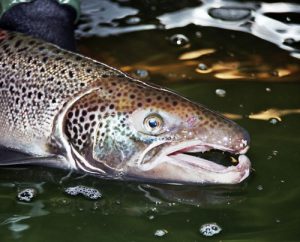In September, the New York State Department of Environmental Conservation (DEC) announced actions underway to mitigate impacts of unusual low water flows along the Salmon River that are likely to affect the fall run of Atlantic salmon.
These include modification of water releases and delayed opening of the river’s lower fly fishing section ahead of the annual run which attracts thousands of anglers every year.
“The modified water releases and delayed opening of the lower fly fishing section are necessary to ensure a successful egg collection at the hatchery to continue New York State’s legacy of a thriving Lake Ontario salmonid fishery” said Region 7 Director Dereth Glance.?
This summer, below-average rainfall led to low and declining water levels in the Salmon River Reservoir. The Executive Committee of the Salmon River Flow Management Team, comprised of natural resource agencies and Brookfield Renewable hydroelectric facility that regulates reservoir water levels, canceled scheduled whitewater releases and delayed the annual increase in baseflow to conserve reservoir water and maintain suitable flows throughout the salmon spawning run.
Under a federal license, Salmon River seasonal baseflows are normally increased from 185 cubic feet/second (cfs) to 335 cfs on Sept. 1, as long as water levels in the Salmon River Reservoir are above a critical threshold.
September levels were well below that threshold, requiring cancelation of a scheduled whitewater release over Labor Day weekend.
Brookfield, in consultation with the New York State DEC, decided to continue with the 185 cfs base flow out of Lighthouse Hill for the beginning of September due to ongoing drought conditions coupled with low reservoir levels.
The base flow was expected to remain reduced until the reservoir recovers to normal historic elevations for the time of year.
DEC’s recommendation was based on abnormally high water temperatures coupled with low water flows in Salmon River tributaries, including Beaverdam Brook where migrating Chinook salmon access DEC’s Salmon River Fish Hatchery for egg collection that support the State’s successful stocking program.
Increasing baseflows prematurely would likely cause Chinook salmon currently “staging” in Lake Ontario to begin their spawning migration into the Salmon River, which could strand and/or kill fish if water temperatures remain high.
Until rainfall sufficiently raises Beaverdam Brook water levels, biologists are concerned that migrating salmon could have difficulty reaching the DEC’s hatchery .
To increase the probability that sufficient numbers of salmon reach the hatchery to sustain the salmon stocking program, the popular lower fly fishing section, located just below the hatchery and typically where large numbers of salmon and anglers congregate, will not open on Sept. 15.
The section was expected to remain closed until DEC collects sufficient numbers of salmon eggs at the hatchery, or at least through October 31.
Alternative fishing locations include the Upper Fly Area located above the hatchery grounds on Route 22, and other alternative recreation areas listed on DEC’s Find Places to Go webpage.
Located in Oswego County New York, the Salmon River flows from the Salmon River Reservoir to the Lighthouse Hill Reservoir (also known as Lower Salmon River Reservoir) onward to Lake Ontario at Port Ontario. Located along the Salmon River are 12 miles of Public Fishing Rights.
Two major fish records have been set on the Salmon River:
- the Great Lakes record Chinook salmon (47 lbs. 13 oz.)
- the world record Coho salmon (33 lbs. 4 oz.).
For more information about salmon fishing in New York, anglers can visit the DEC website.
source: New York State Department of Environmental Conservation
